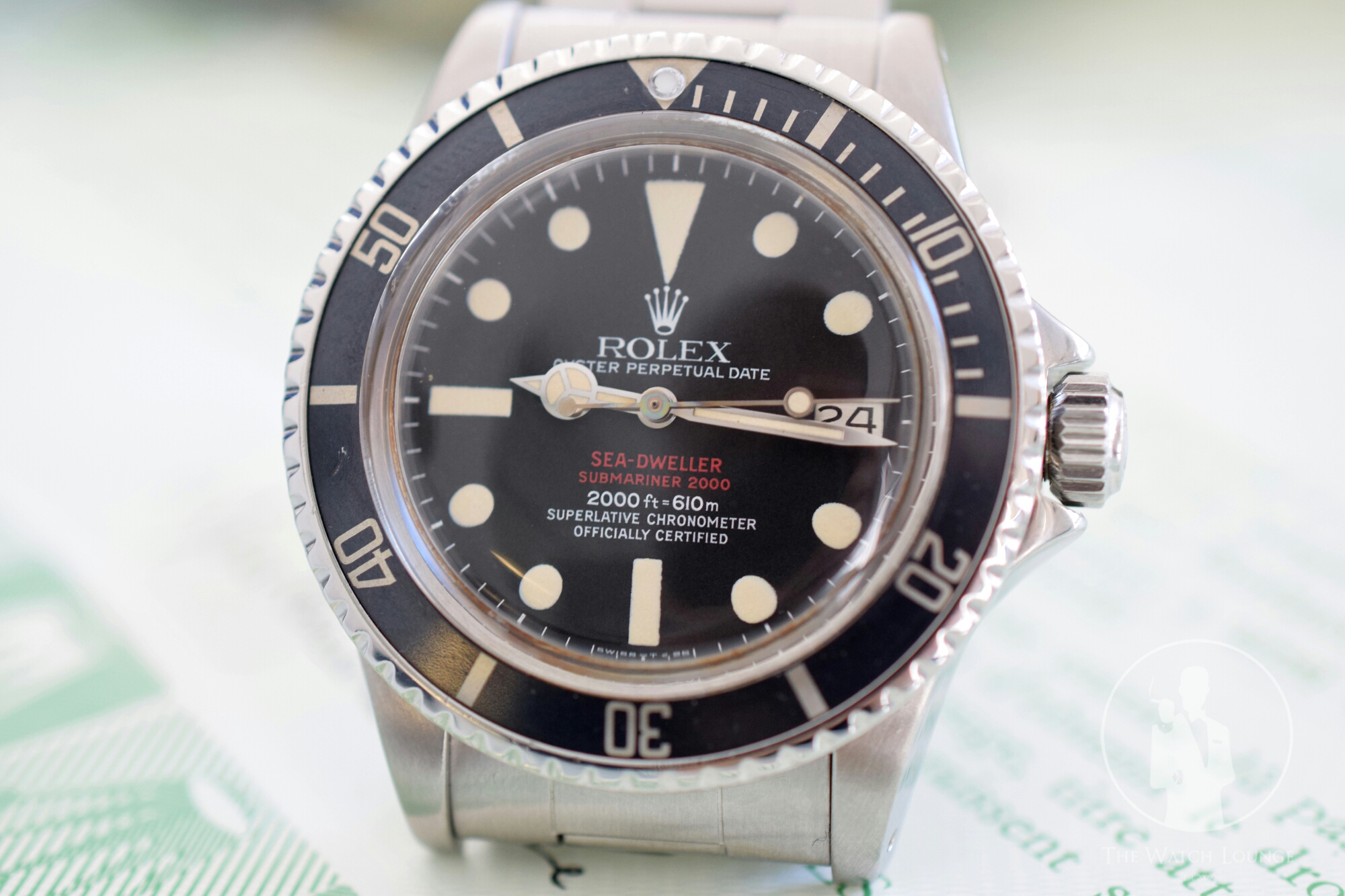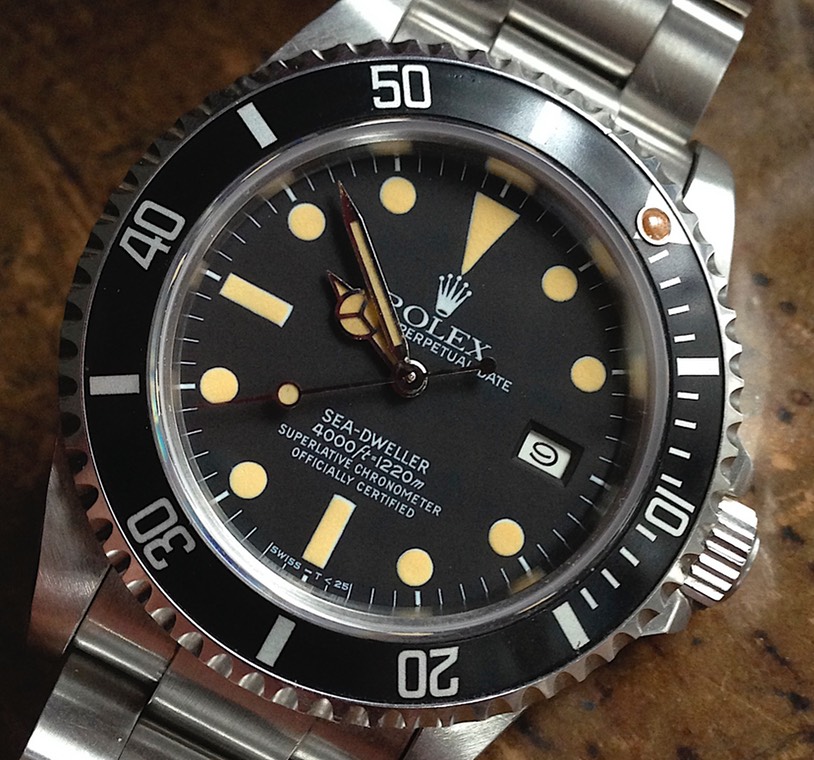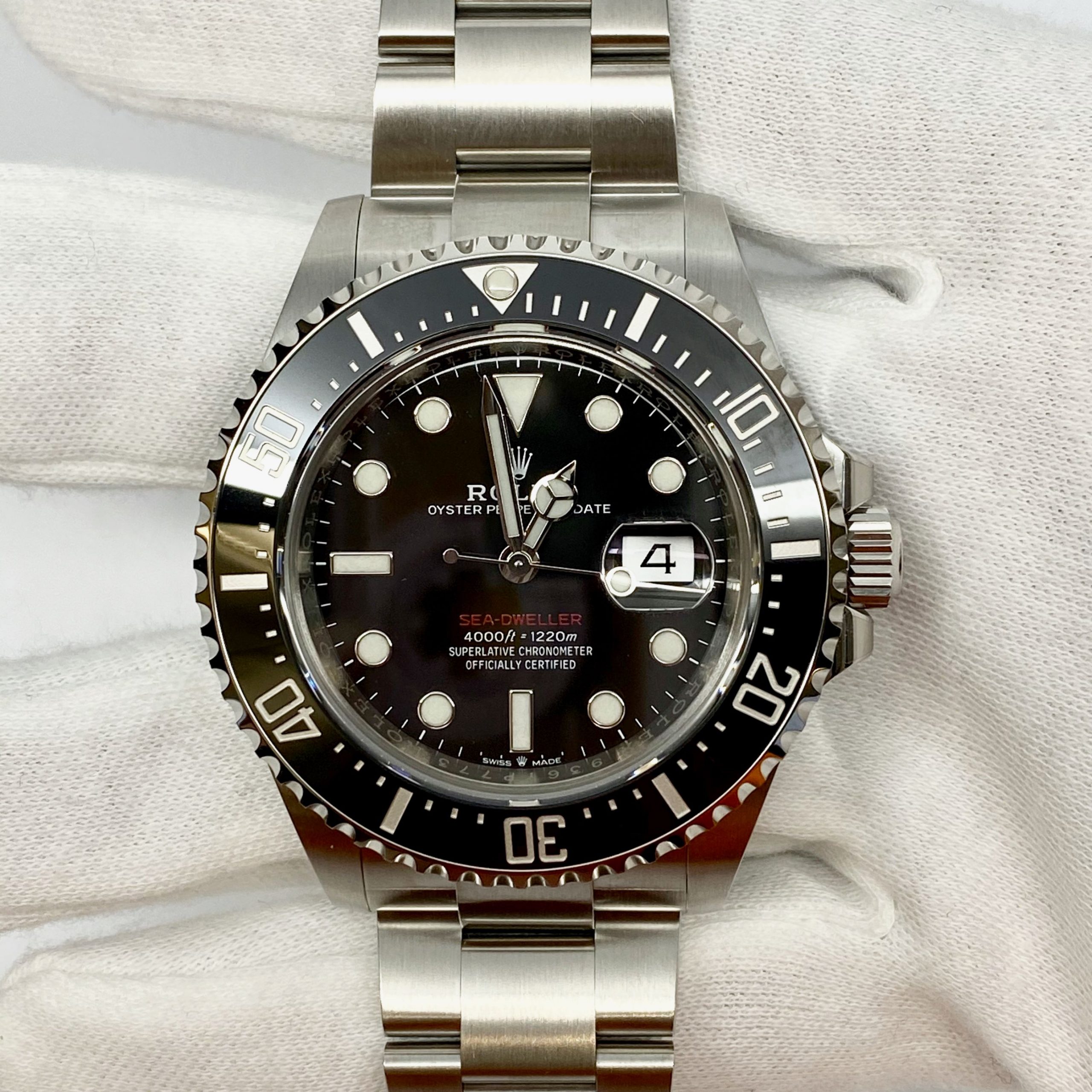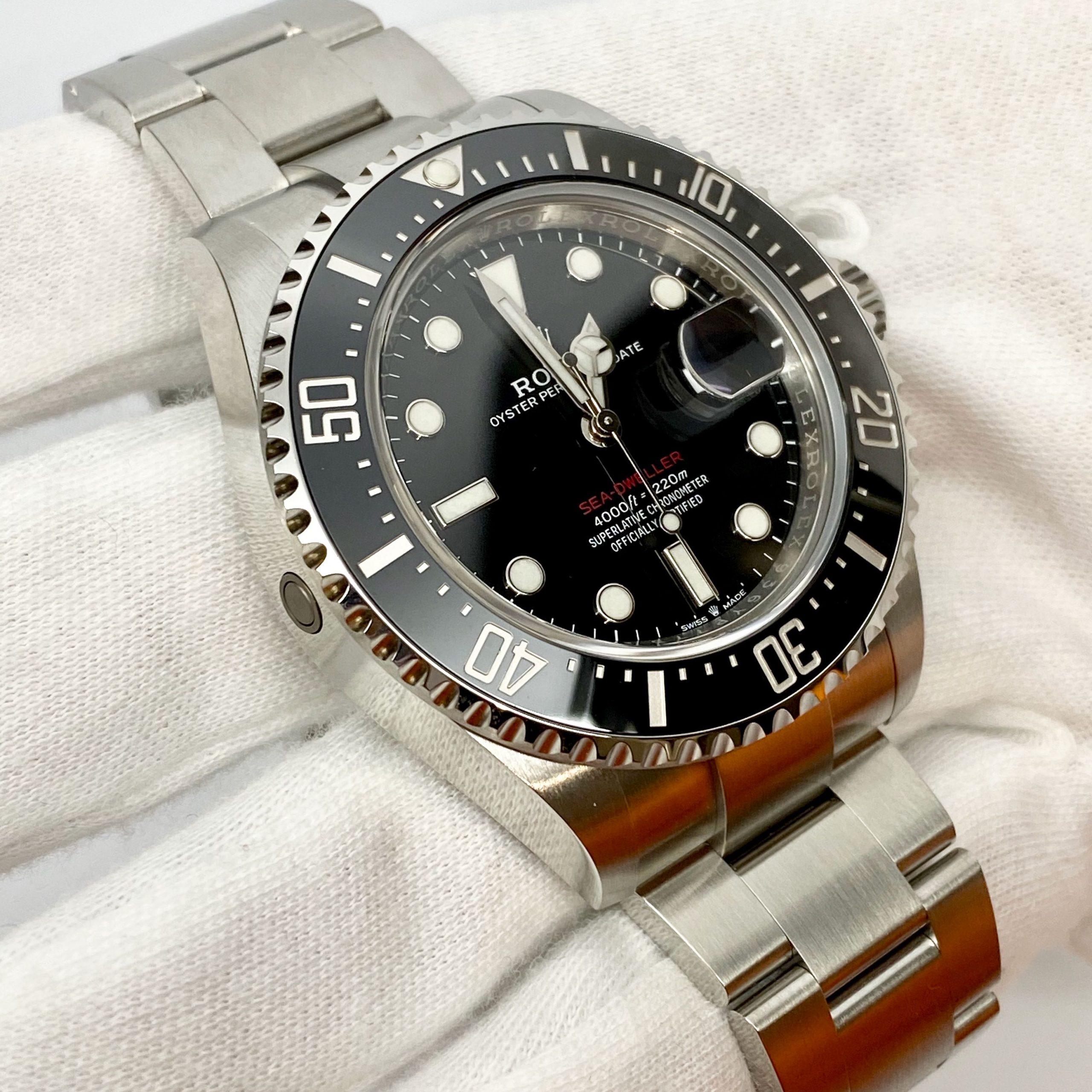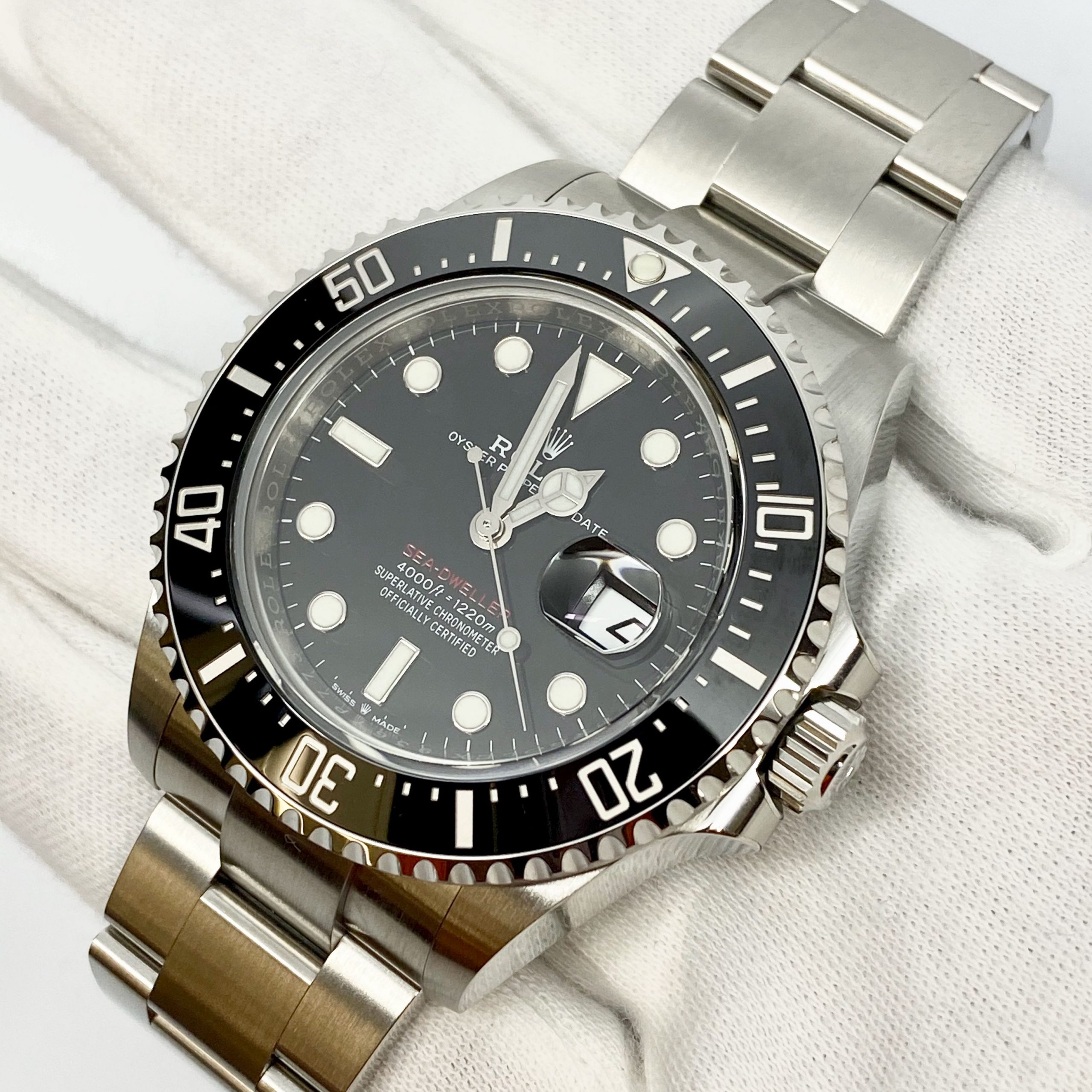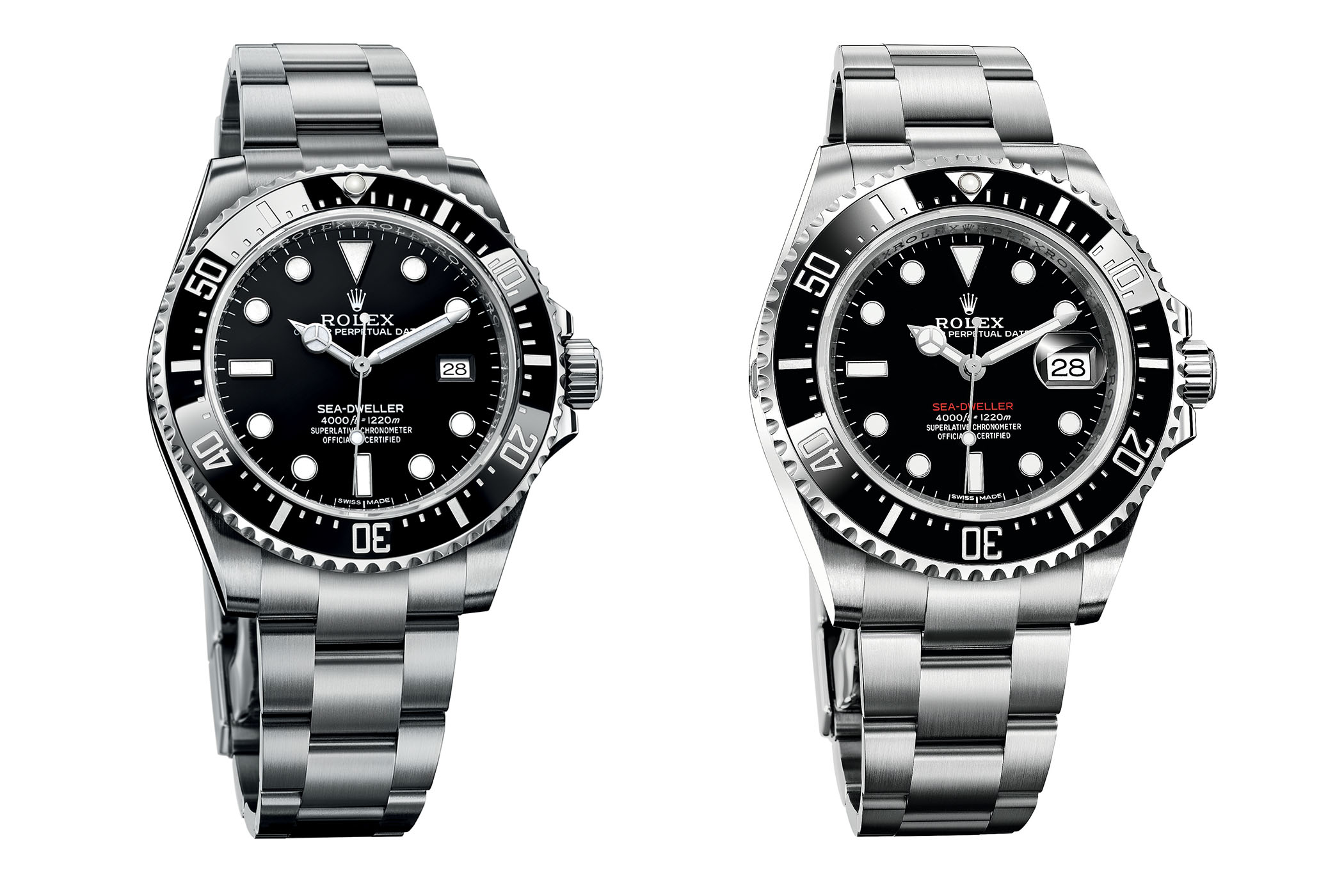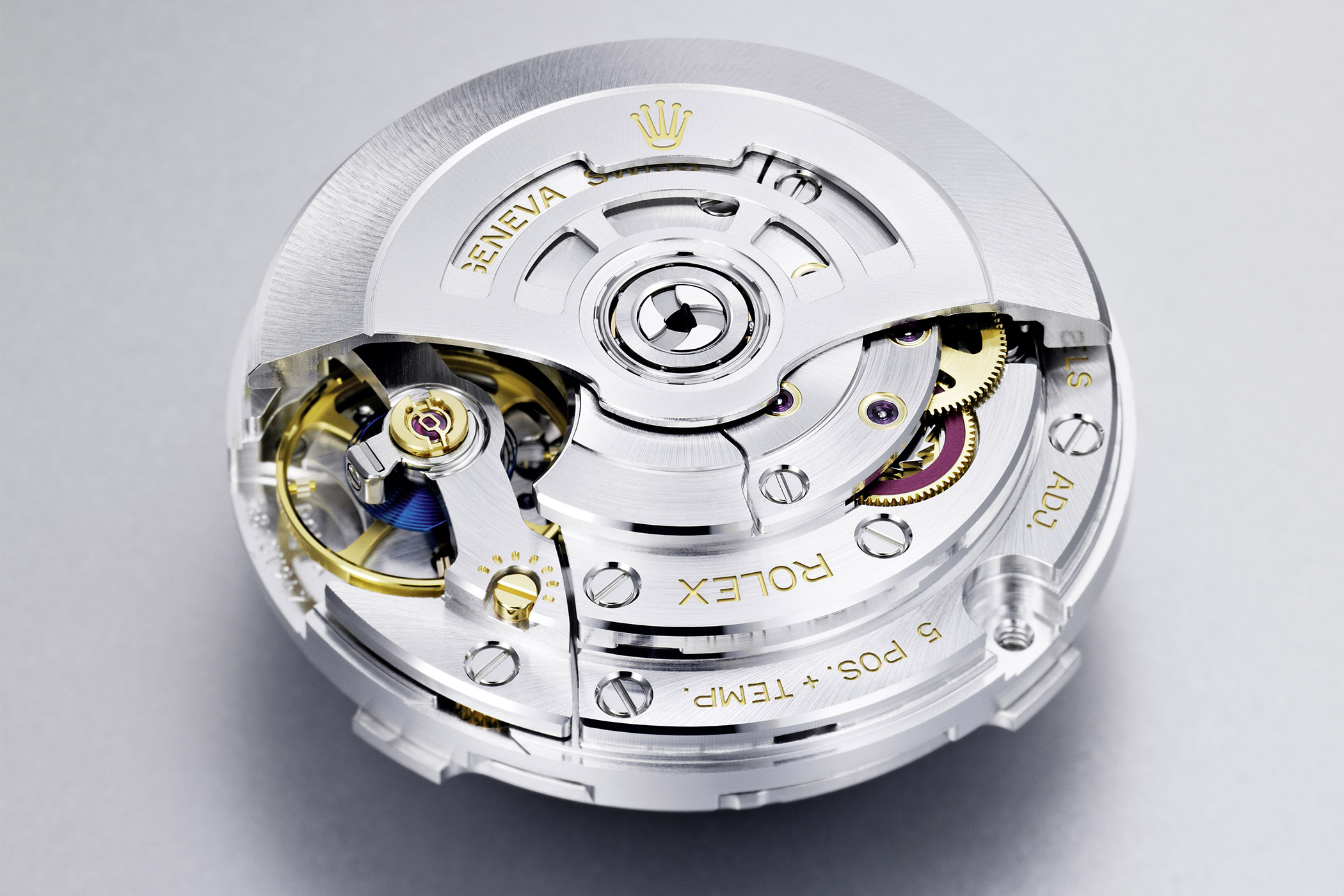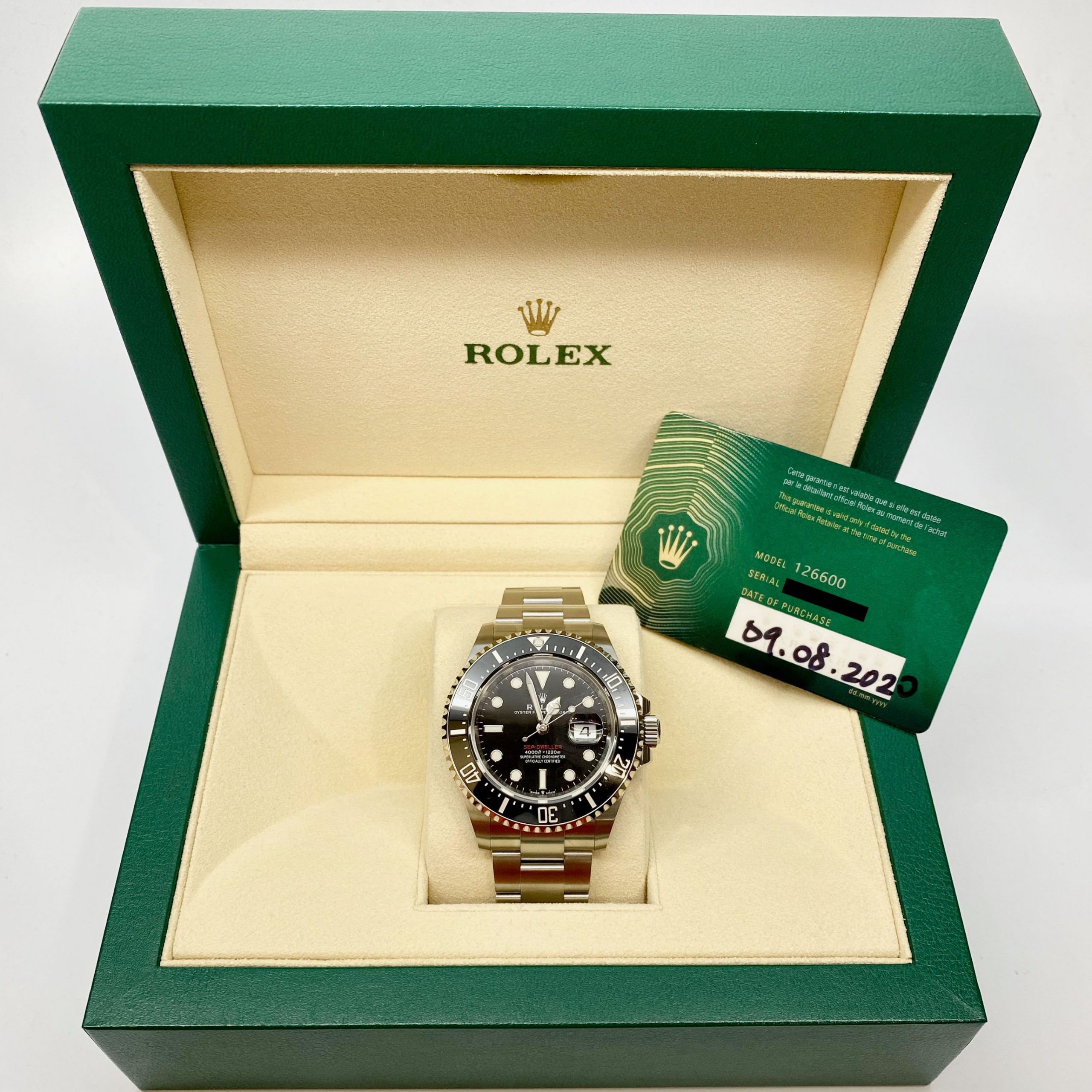The Rolex Sea-Dweller Single Red Ref 126600 is an epic mechanical dive watch. Waterproof to 1,220 metres (4,000 feet) it’s somehow still practical and stylish enough to wear every day. There are few dive watches of this pedigree that you can rock with a suit at the office. And a (wet)suit in the water. It’s no surprise then that the Sea-Dweller has a devoted legion of fans. Yet this is not a watch for everybody. It’s bigger and thicker and less commercial than its elder sibling the Rolex Submariner. It’s also more expensive. This is everything you need to know about the Rolex Sea-Dweller 126600.
A (Very) Brief History Of The Rolex Sea-Dweller
Everybody knows the Rolex Submariner. Launched in 1954, it was the world’s first commercially produced dive watch. It was targeted at amateur divers. Diving was growing in popularity and enthusiasts needed a reliable way to track dive times. The watch needed to be functional and reliable, but also attractive. This was a commercial product after all. People wanted to be able to wear their watch diving, but also out to dinner.
The Rolex Sea-Dweller meanwhile did not start out life as a commercial product. It was not designed for the masses. Instead, it was created to serve a specific audience. Professional deep-sea divers. People who spent long periods underwater using a technique called saturation diving. The original concept was developed in conjunction with COMEX. The French company specialized in engineering and deep diving operations in the 1960s. At the time they needed a diving watch for their professional divers to use whilst working on deep sea oil rigs.
The Problem With Saturation Diving
The goal of saturation diving is to reduce the risk of decompression sickness. This requires the diver to spend prolonged hours in diving bells under pressure as they return to the surface. While in these bells, they breathe a helium–oxygen mixture to prevent nitrogen narcosis. Over time the pressure is reduced. Eventually the diver is decompressed back to the surface pressure.
- A diving bell being lowered to the sea floor.
This is all well and good for the diver. The problem for watchmakers though was the helium molecules in the gas mix the divers breath. Helium molecules are tiny. In fact, helium atoms are the smallest natural gas particles found in nature. This means that when the diver is in the bell, helium is slowly working its way into his or her watch. Over time, the pressure inside the watch equalizes with the pressure in the bell. However, the pressure within the bell is not constant. It is reducing to help the diver get back to normal atmospheric pressure. This causes a pressure differential. The result of which invariably leads to the crystal of the watch popping off. Not exactly ideal for a dive watch.
The Helium Escape Valve
Working with COMEX and Doxa S.A., Rolex developed and patented the helium escape valve. A one-way valve, it activates when the differential between the inner and the outside pressure reaches a critical level. This allows the helium and any other gases used in the breathing gas to be released from inside the watch case. A specific reference was created for COMEX (Submariner ref 5514.) Following on from this, Rolex launched a new model fitted with helium escape valves. The Sea-Dweller Ref 1665 came to market in 1967. It was targeted at professional deep-sea divers. The initial model was water resistant to 2,000ft (610 meters), an impressive feat at the time.
- The Rolex Sea Dweller Ref. 1665 for professional divers.
The early designs were like that of the Submariner Ref 5514 COMEX. To help differentiate the Sea-Dweller, Rolex used red text on the dial. Today, these models are known to collectors as “double red” Sea-Dwellers. That’s because the words “Sea-Dweller” and “Submariner 2000” are printed in red. There were also “single red” versions with only the name “Sea-Dweller” in red. These models were prototypes only though and were rated waterproof to 500m.
The year before, Rolex debuted the Rolex Submariner Ref 1680. This was the first Submariner to feature a date window, complete with cyclops. It follows then that Sea-Dweller would have a date display too. There was no cyclops though. That’s because it would have popped off during depressurisation.
The Evolutions
A decade later, Rolex revisited the design of the Sea-Dweller. The red text became white. And the “Submariner 2000” line disappeared altogether. This was to help establish the Sea-Dweller as its own model. A more serious update came in 1978 in the form of the Ref 16660. This model boasted a sapphire crystal and a bigger helium release valve. Its depth rating was also improved to 4,000 feet or 1,220 metres.
- A matte dial Sea-Dweller Ref 16660 – Credit DRSD.com
In 1988, Rolex launched the Ref. 16600. It built on the updates made ten years earlier. Improvements included a glossy black dial and solid end-links on the bracelet. Inside was the calibre 3135, representing the latest innovations from Rolex at the time. This model would remain in production for the next twenty years. In 2008 it was replaced by the Rolex Sea-Dweller Deepsea Ref 116660.
Over time though it became apparent that the Deepsea was not suitable for everyone. Devoted fans of the Sea-Dweller missed their favourite model. So, following a six-year hiatus, Rolex brought back the Sea-Dweller 4000. The Ref 116600 introduced a slimmer 40mm case, a ceramic bezel and a Glidelock bracelet. There was still all white text on the black dial and no cyclops over the date window.
The Rolex Sea-Dweller Ref 126600
IN THE SHOP: check out this unworn Rolex Sea-Dweller Ref 126600 Single Red available now.
In 2017, the Ref 116600 was discontinued. At the same time, the Ref 126600 made its debut, 50 years after the original. Although not officially titled as such, collectors refer to it as the “50th anniversary” Sea-Dweller. This model was a hotly anticipated release from Rolex. Everyone expected the brand to do something for the 50th anniversary. And do something they did. Yet, the unveiling of the new Sea-Dweller caused quite a bit of controversy. This is because it introduced some significant changes.
Let’s dive (*cringe*) into them in more detail.
Case:
The biggest change with the new Sea-Dweller Ref 126600 is the case size. Literally. Previous models shared the same 40mm diameter as the Rolex Submariner. It’s a comfortable size. Well suited to most wrists. But the Sea-Dweller is not designed for most wrists. Its intended use is as a professional grade dive watch. That’s why the case is now 43mm in diameter. Its larger size makes it easier to see and use underwater. This increase in stature also differentiates it from the Submariner. Before, the only way to tell the two apart from a short distance away was by the tell-tale cyclops. Of course, that too has changed now. But more on that in a minute.
The Oyster case is manufactured from corrosion-resistant 904L steel. Rolex calls this Oystersteel. The material is resilient even in harsh environments and lends itself well to polishing. The case construction uses a monobloc middle case and screw-down case back. The screw-down crown features Rolex’s patented Triplock triple waterproofness system. On the left side of the case is the integrated helium escape valve. Together these elements work to keep the Ref 126600 water tight to 1,220m.
IN THE SHOP: check out this unworn Rolex Sea-Dweller Ref 126600 Single Red available now.
To ensure it is comfortable on the wrist, Rolex redesigned the case of the Sea-Dweller. The lugs are shorter and more curved and the height to width ratio is in better proportion. It’s big, but not as big as the Rolex Deepsea Ref 126660. Framing the dial is a unidirectional rotatable 60-minute graduated bezel. It is equipped with a patented black Cerachrom bezel insert manufactured by Rolex. The ceramic is virtually scratch-proof and its colour is unaffected by ultraviolet rays. The numerals and graduations on the bezel are coated with a thin layer of platinum.
You will also notice the bezel has 1-minute markings from 0 all the way to 60. This is not the case for bezel of the Submariner. On that model, the markings run from 0 to 15.
Dial:
The increase in case size was unexpected. But it wasn’t the most controversial change from Rolex. That instead came on the dial. More specifically, on the sapphire crystal protecting the dial. After 50 years of no cyclops, Rolex put a cyclops over the date of its new Sea-Dweller Ref 126600. This pissed a lot of people off. Many of the model’s fans loved the fact that it didn’t have this polarising trait. At least it didn’t use to.
IN THE SHOP: check out this unworn Rolex Sea-Dweller Ref 126600 Single Red available now.
The explanation from Rolex was simple. Previously the company had not been able to devise a technical solution that would allow for a cyclops to remain intact on deep dives. Now they had. Having a cyclops in place makes the date easier to read. Rolex is all about continuous improvement. Therefore, if there is a way to make a watch more functional, it will be done.
Ironically, adding a cyclops is counter-productive to differentiating the Sea-Dweller from the Submariner. But Rolex had a solution for this too. It reintroduced red text to the dial of the Sea-Dweller. A subtle reference to the first prototypes that collectors love. It’s an unusual step for a brand that’s always looking forward. But Rolex never does anything by chance. Hindsight shows it was a smart move and one that has paid serious dividends.
The larger case also means a larger dial. To keep everything in proportion the hands and indexes are also larger. This has the added benefit of making the Sea-Dweller Ref 126600 more legible. The change is noticeable when you put the new model and old model side by side.
- The old 116600 on the left vs the new 126600 on the right.
To ensure legibility in all conditions, the black dial features Rolex’s innovative Chromalight display. It emits a distinctive blue glow in low light conditions. Anyone who’s seen it will tell you how effective it is. The blue glow delivers uniform luminosity for up to eight hours.
Bracelet:
The larger dimensions of the case mean a larger bracelet is required. The solid-link Oyster bracelet in Oystersteel is now 22mm. Versus its 20mm predecessor. It also features a larger buckle. The buckle on the previous Ref 116600 was criticised for being too thin. So, Rolex has corrected that here. An Oysterlock safety clasp prevents accidental opening.
A double extension system allows adjustments to be made without the use of tools. This means the watch can be worn comfortably over a diving suit up to 7 mm thick. The Fliplock extension link extends the bracelet by 26 mm. For day to day wear with a normal suit, the Rolex Glidelock system allows fine adjustment of the bracelet length. Adjustments can be made in 2mm increments for a total of approximately 20 mm.
Movement:
Inside the Sea-Dweller Ref 126600 is the new generation calibre 3235. This is the same movement used in the Rolex Datejust 41. This self-winding mechanical movement is developed and manufactured by Rolex. It boasts 14 patents in total, including the new Chronergy escapement. This escapement combines high energy efficiency with great dependability. Made of nickel-phosphorus, it is also insensitive to magnetic interference. New barrel architecture and superior efficiency means a power reserve of 70 hours. The 3235 carries the Superlative Chronometer certification redefined by Rolex in 2015. This means it is very accurate (−2/+2 seconds per day) and reliable.
- The Rolex Calibre 3235
Price And Availability:
The price of the Rolex Sea-Dweller Ref 126600 is USD 11,350. Like just about every steel sports watch from Rolex it’s in high demand. And short supply. Prices on the secondary market aren’t as crazy as some other models though. Expect to pay between USD 14,000 and USD 15,000.
IN THE SHOP: check out this unworn Rolex Sea-Dweller Ref 126600 Single Red available now.
Technical Specifications: Rolex Sea-Dweller Single Red Ref 126600
- Case: Oyster – 43 mm – Oystersteel – monobloc middle case, screw-down case back and crown with Triplock triple waterproofness system – Unidirectional rotatable 60-minute graduated, scratch-resistant Cerachrom insert in ceramic, numerals and graduations coated in platinum – waterproof to 1,220 metres / 4,000 feet.
- Dial: Black – scratch-resistant sapphire, Cyclops lens over the date – centre hour, minute and seconds hands – instantaneous date – stop-seconds for precise time setting – Chromalight display with longlasting blue luminescence on hour markers and hands.
- Movement: Calibre 3235 – bidirectional self-winding via Perpetual rotor – paramagnetic blue Parachrom hairspring – Chronergy escapement with optimized energy efficiency – 70-hour power reserve – certified as Superlative Chronometer.
- Price: USD 11,350.
This article by TheWatchLounge has been sponsored by our partner WatchBox.

